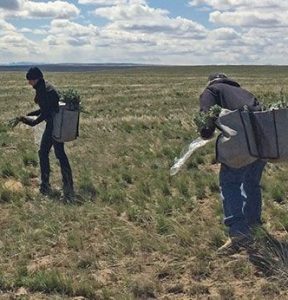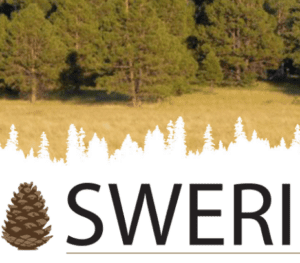Restoration
Webinar recording.
Climate Impacts on Regeneration-
Hear from three subject-matter experts on seedling success across elevational ranges and with varying genotypes:
Justin Crotteau, Research Forester, Rocky Mountain Research Station
Aalap Dixit, Assistant Professor, New Mexico Highlands University
Bryce Richardson, Research Geneticist, Rocky Mountain Research Station
Indigenous Knowledge Exchange and Work on the Ground!
Hear from two case study experts on utilizing Indigenous knowledge for cultural values on pre- and post-burned landscapes:
James Calabaza, Trees Water People
Nona (Nanebah) Lyndon, Tribal Relations Staff Officer, Tonto National Forest, Kaibab National Forest
Sara Souther, Assoc. Professor, Northern Arizona University
Policy In The Works-
An update on the RePlant Act, and implications for land managers.
Kas Dumroese, National Nursery Specialist & Research Plant Physiologist, Rocky Mountain Research Station
View report.
Our findings suggest that all deserts exhibited vulnerability to increasing fire disturbance because relatively low soil seed densities may not provide enough propagules for revegetation. Therefore, seeding of these communities may be especially important. In the cold deserts, this susceptibility was further evidenced by the fact that aboveground community composition in fire-affected areas was significantly different from the nearby unburned community even 30 years after fire and burned communities were associated with non-native species. That said, native species did exist in seed banks of burned sites and some taxa, like Sporobolus sp., occurred in high densities. Therefore, caution may be needed when using herbicide treatments to control exotic species as there may be unintended consequences of decreasing desirable species. In contrast, our warm desert sites exhibited less change in terms of seed densities, species richness and aboveground community composition following fire. In the face of more frequent fires, the lack of shrub seeds in the seed bank of all deserts was notable and we found no evidence of greater seed densities or unique species assemblages associated with shrub microsites.
View article.
We tested the effects of site environmental variables (elevation, mean annual precipitation, heat load, and clay content) and management choices (seed source and planting date) on germination favorability and barrier occurrence (mean) and variability (coefficient of variation). Seedling exposure to barriers was strongly linked to management decisions in addition to site mean precipitation and elevation. Later fall plantings and seed sources with slower germination (lower mean germination favorability) were less likely to encounter freezing and drought barriers. These results suggest that management actions can play a role comparable to site environmental variables in reducing exposure of vulnerable seedlings to adverse weather conditions and subsequent effects on restoration outcomes.
View article.
We evaluated seeding bitterbrush (Purshia tridentata) after wildfire in former western juniper (Juniperus occidentalis ssp. occidentalis) canopy compared with interspace microsites at six locations for 3 yr post seeding. Bitterbrush abundance was 3.6-fold greater in former canopy compared with interspace microsites after 3 yr. Bitterbrush height was 1.5 to 2.5-fold greater in former canopy compared with interspace microsites. The first year after fire, exotic annual grass cover was 15.6-fold greater in interspace compared with canopy microsites. Abundance and cover of other herbaceous vegetation were generally also greater in the interspace. Exotic annual grass and native bunchgrass abundance increased substantially over time in former canopy microsites, suggesting abundant resource availability. Less herbaceous competition and presumably greater resource availability in former canopies probably resulted in greater success of seeded bitterbrush. These results suggest that capitalizing on spatial variability in environments can be used to increase restoration efficiency. After fire in western juniper−encroached rangelands, former juniper canopy microsites are a favorable environment for establishment and growth of seeded bitterbrush and could be targeted for restoration efforts to improve efficiency.
Course website and registration link
Watch the course trailer
Are you interested in joining the global movement to restore our world? Do you want to become more skilled at preventing, halting, and reversing the degradation of ecosystems? Are you looking to create a national blueprint for ecosystem restoration in your country? The United Nations Development Programme (UNDP) and the Convention on Biological Diversity are offering a FREE Massive Open Online Course on Ecosystem Restoration.
This course compiles research from leading institutions engaged in ecosystem restoration to build awareness and skills on the process of restoring ecosystems. The course serves as an introduction to the Short-Term Action Plan on Ecosystem Restoration (STAPER) – a methodology adopted by the United Nations Convention on Biological Diversity to support governments in the development and implementation of their national restoration strategies.
The course starts on 19 September 2022. It is designed to support government representatives in creating a national blueprint for ecosystem restoration, but is open to everyone.
Visit workshop website.
All-lands forest and fire management in Arizona, Colorado, New Mexico, and surrounding states
- Share successes and lessons learned on cross-boundary, collaborative efforts to restore and reimagine fire-adapted forest landscapes
- Co-develop knowledge, recommendations, strategies, and resources for collaborative landscape-scale restoration projects
- Explore gaps and strategies to empower diverse perspectives, and enhance inclusivity and equitability of forestry and fire research and management
- Our 2020 Workshop attendance sold out and exceeded the venue capacity. We have increased capacity at the 2023 venue to accommodate 300 participants and are hopeful for another full house. Register early to ensure your attendance!
Who should attend? Government, tribal, and non-government foresters, fire managers, planners, biologists, line officers, regional and national program managers, forest researchers, conservation organizations, funding partners, forest operations companies, and other stakeholders interested in applying science and tools for all-lands collaborative forest landscape restoration.
Access some of the recorded presentations.
The National Native Seed Conference connects Research, Industry, Land Management, and Restoration professionals, providing the premier opportunity to develop relationships and share information about the collection, research and development, production, and use of native plant materials.
The 2023 National Native Seed Conference is dedicated to the science, practice, and policy of producing and effectively using native seed. The conference supports the America the Beautiful Executive Order, National Seed Strategy for Rehabilitation and Restoration, and the UN Decade on Ecosystem Restoration.
Conference sessions will cover several topics, including:
- Wild seed collection
- Seed production
- Industry opportunities and best practices
- Traditional Ecological Knowledge
- Evaluation and Research
- Seed Partnerships
- Wildlife and Pollinators
View article.
Tree planting has long been promoted to avert climate change and has received renewed impetus in recent years with the Bonn Challenge and related forest restoration initiatives guided by the forest and landscape restoration (FLR) framework. Much of the focus for reforestation and afforestation is on developing countries in Africa, Asia and South America, where large areas of rangelands in drylands and grassy biomes are portrayed as “degraded,” “unused,” and in need of more trees. This perception is rooted in persistent theories on forests and desertification that widely shaped colonial policy and practice and remain influential in today’s science-policy frameworks. From a rangelands perspective, the global FLR thrust raises two main concerns. First, inappropriate understandings of the ecology of drylands and grassy biomes encourage afforestation, grazing restriction and fire suppression, with negative impacts on hydrology, carbon storage, biodiversity, livestock production and pastoral livelihoods. Second, their target-driven approach requires large-scale afforestation and massive funding to achieve. Nearly half of the area pledged to the Bonn Challenge is in fact destined for forestry and other commercial plantations, which threaten pastoral livelihoods and cause ecological damage while having very limited potential to mitigate climate change. As the officially endorsed framework of the Bonn Challenge and related global restoration initiatives, FLR has become a powerful instrument for guiding global restoration efforts and funding. Its proponents have a responsibility to ensure that the framework is evidence-based and underpinned by appropriate ecological models for different ecoregions.
View article.
Invasive annual grasses, wildfire, and climate change are changing ecosystem processes in the sagebrush biome at a pace and scale requiring an assessment of where processes can be saved, where they can be regained, and where they are lost. Confronting these threats is the primary focus of restoration and management efforts, guiding policy creation, project prioritization, and action on the ground. The new Defend the Core framework helps land managers, landowners, and policy makers to use the tools or management actions most likely to improve conditions.
View article.
Collaborating at the planning stage of restoration projects can be slow. It takes time to build relationships, and meeting people “where they are at” is often the accomplishment. Success in collaboration comes from gathering the local knowledge to move forward with implementing projects. Long-standing collaborative groups often face challenges with keeping stakeholders and partners involved particularly when tracking past projects. Finding continued funding to maintain the projects implemented years earlier takes effort usually on behalf of the convening organization.







